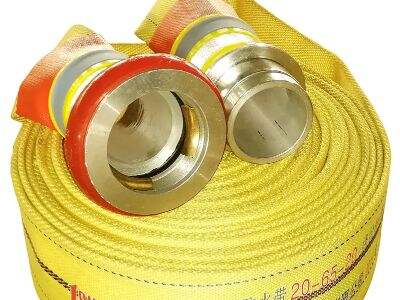Why it's Important to Test Fire Hose Burst Pressure:
A test of fire hose burst pressure is critical so that the canvas hoses is strong enough to withstand the pressure of the water when the fire hose is in use to extinguish a fire. Were a fire hose to burst while in use, it could pose a danger to firefighters and thereby make it more difficult to effectively extinguish a fire. Firefighters also test the burst pressure of the fire hose before using it to assure themselves of the safety and dependability of their equipment.
How to Perform Fire Hose Burst Pressure Testing:
Examine the fire hose for wear or damage.
Attach the fire hose to a water supply, such as a fire hydrant.
Plugging up the other end of the canvas hose
will be a special testing cap.
Gradually turn on the water, allowing the pressure to build up in the hose.
Watch the pressure gauge to determine how much pressure the hose can support before it bursts.
When the hose bursts, the gauge will indicate the NC.
Protecting Firefighters with Comprehensive Testing for Hose Pressure:
Performing periodical test of fire hoses’ burst pressure tests, firefighters can make certain their equipments are reliable. “The fact that you know your hose lines can withstand the high pressure of water gives the guys more confidence to be able to work properly and safely. This is why comprehensive canvas lay flat hose pressure testing is a critical part of firefighter training and apparatus care.There are some important factors to take into account when testing the bursting pressure of a fire hose to obtain reliable and accurate testing results. These factors include the age and state of the hose, the nature of the materials with which the hose was manufactured and the temperature and pressure of the water being used to test the hose. It allows forces such as friction to be considered so that firefighters can determine the maximum pressure that can be used without causing the hose to burst.
How to Test Fire Hose Burst Pressure Prior to Use:
Test all fire hoses regularly and inspect the burst pressure.
Record the results of each test for future reference.
Replace all hoses that do not comply with the minimum burst pressure specification.
Provide all fire fighters with training on how to perform hose pressure tests correctly.
When testing fire hoses, never neglect safety precautions to avoid any accidents or injuries.

 EN
EN
 AR
AR
 FR
FR
 DE
DE
 KO
KO
 CS
CS
 DA
DA
 NL
NL
 FI
FI
 EL
EL
 IT
IT
 JA
JA
 NO
NO
 PL
PL
 PT
PT
 RO
RO
 RU
RU
 ES
ES
 SV
SV
 TL
TL
 IW
IW
 ID
ID
 LV
LV
 LT
LT
 SR
SR
 SK
SK
 SL
SL
 UK
UK
 SQ
SQ
 ET
ET
 HU
HU
 TH
TH
 TR
TR
 FA
FA
 AF
AF
 IS
IS
 MK
MK
 KA
KA
 UR
UR
 BN
BN

